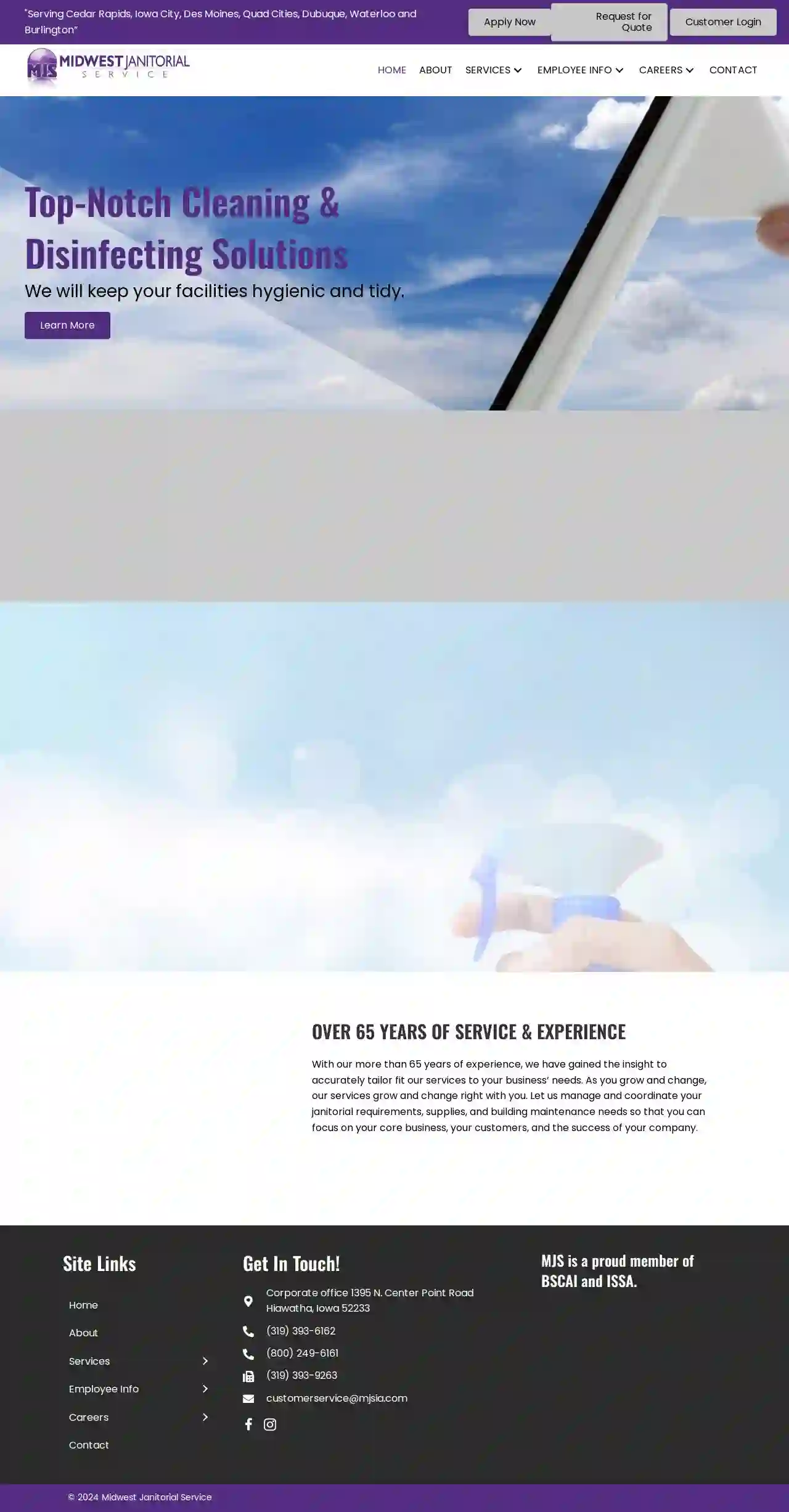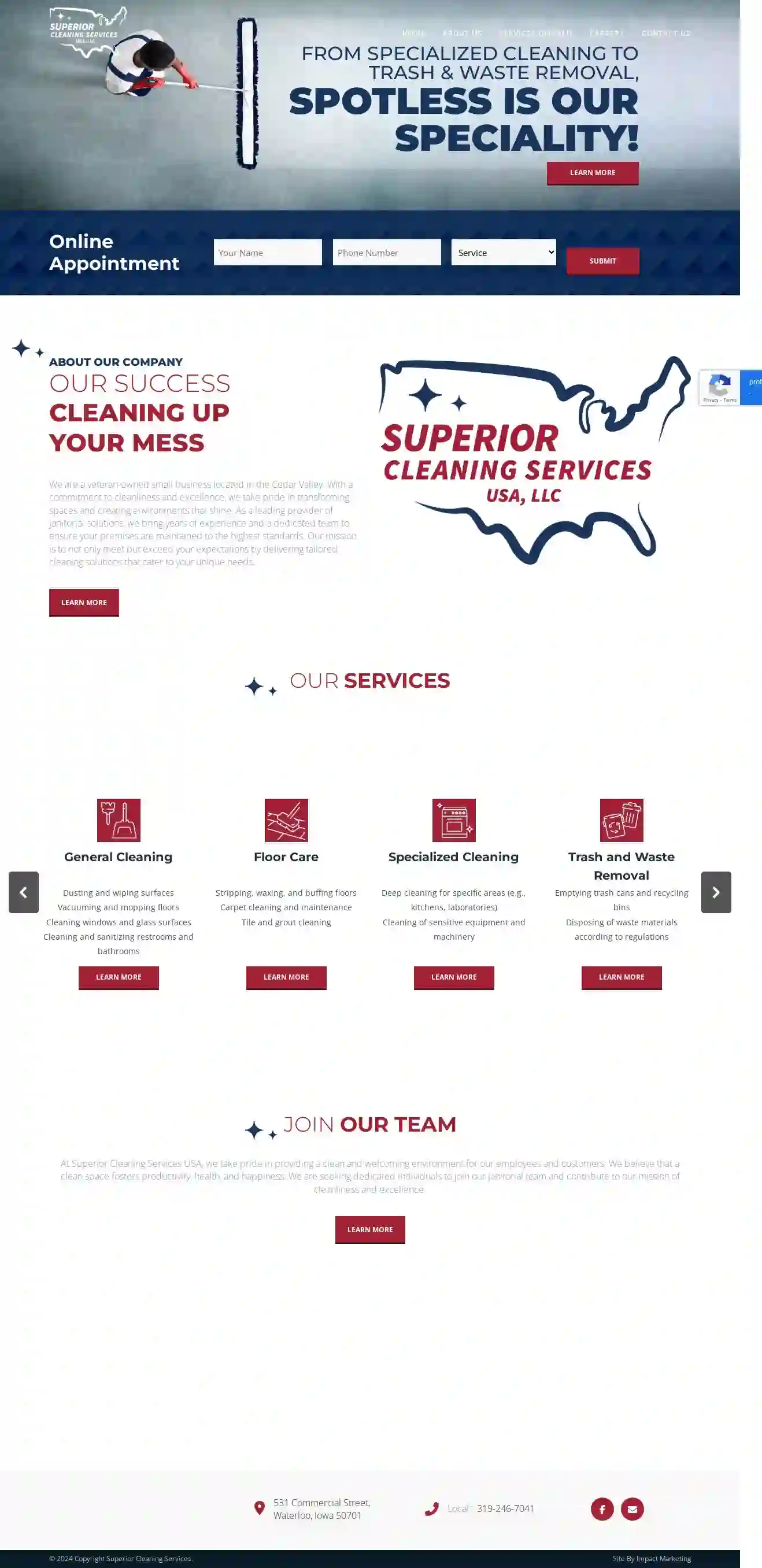Cleaning Services Anamosa
Best Home Cleaning in Anamosa
Receive multiple Cleaning Companies quotes for your project today! Compare profiles, reviews, accreditations, portfolio, etc... and choose the best service.

Sparkling Clean
3.17 reviewsCedar Rapids, US- Services
- Why Us?
- Gallery
Get Quote
1Procleaning
Iowa City, IA, 1570 S 1st Avenue Suite, 52240, US1Procleaning is dedicated to providing high-quality commercial cleaning services to businesses and homes in eastern Iowa. Our team of experienced and professional cleaners is committed to using the latest tools and techniques to ensure your business and space look their best. We provide quality and professional commercial and residential cleaning services to businesses in eastern Iowa.
- Services
- Why Us?
- Accreditations
- Our Team
- Testimonials
- Gallery
Get Quote
Streamline CleanPro
525 reviewsCedar Rapids, US- Services
- Why Us?
- Gallery
Get Quote
Subi Shine Cleaning
58 reviewsCedar Rapids, US- Services
- Why Us?
- Gallery
Get Quote
Liberty Cleaning Solutions
4.715 reviewsCedar Rapids, US- Services
- Why Us?
- Gallery
Get Quote
Midwest Janitorial Service
3.937 reviewsCedar Rapids, US- Services
- Why Us?
Get Quote
Midwest Janitorial Service, Inc.
4.99 reviews123 Main St, Chicago, 60611, USMidwest Janitorial Service is a family-owned and operated business that has been providing top-notch cleaning services to residential and commercial properties in the Midwest region for over 20 years. Our mission is to deliver exceptional cleaning experiences that exceed our customers' expectations, while maintaining a commitment to environmental sustainability and social responsibility. Our team of highly trained and experienced professionals use eco-friendly cleaning products and state-of-the-art equipment to ensure a thorough and efficient cleaning process. We take pride in our attention to detail, reliability, and customer service, which has earned us a reputation as one of the most trusted and respected cleaning services in the area.
- Services
- Why Us?
- Accreditations
- Our Team
- Testimonials
Get Quote
Superior Cleaning Services USA LLC
Waterloo, Iowa, 531 Commercial Street, 50701, USSuperior Cleaning Services USA is a veteran-owned small business located in the Cedar Valley, dedicated to providing a clean and welcoming environment for employees and customers. With a commitment to cleanliness and excellence, they take pride in transforming spaces and creating environments that shine. As a leading provider of janitorial solutions, they bring years of experience and a dedicated team to ensure premises are maintained to the highest standards. Their mission is to not only meet but exceed expectations by delivering tailored cleaning solutions that cater to unique needs. With a focus on attention to detail, reliability, and eco-friendly practices, they have earned a reputation for being a dependable partner for businesses across various industries.
- Services
- Why Us?
- Accreditations
- Our Team
- Testimonials
- Gallery
Get Quote
Professional Kitchen Exhaust Cleaning
3.813 reviewsDes Moines, US- Services
- Why Us?
- Gallery
Get Quote
Office Pride Commercial Cleaning Services of Cedar Rapids
3.134 reviewsCedar Rapids, USAt Office Pride, we deliver high-quality cleaning, sanitizing, and disinfecting services to ensure your workplace is healthy and safe for everyone. Our expert cleaning crews follow industry best practices, wear top-notch personal protective gear, and adhere to all guidelines from OSHA, the CDC, and the EPA. Safety and cleanliness are our top priorities! We work hard so you can work harder. That’s why our Healthy Clean SystemTM is customized to fit your business, facility—or mess. We’ve got you covered.
- Services
- Why Us?
- Gallery
Get Quote
Over 60,241+ Janitorial Businesses registered
Our janitorial services operate in Anamosa and surroundings!
CleaningMatch has curated and vetted Top Janitorial Contractors arround Anamosa. Find a top & trustworthy pro today.
Frequently Asked Questions About Cleaning Services
- Ventilation: Open windows and turn on the exhaust fan to improve air circulation.
- Declutter: Remove any items from countertops, the shower, and the floor to allow easy access.
- Pre-treat: Spray shower walls, tub, and toilet bowl with bathroom cleaner and let it sit for a few minutes to break down grime.
- Toilet: Scrub the toilet bowl with a toilet brush, paying attention to the rim and under the seat. Wipe down the exterior of the toilet with a disinfectant wipe.
- Shower/Tub: Scrub the shower walls and tub with a sponge or scrub brush. Rinse thoroughly.
- Sink: Clean the sink with a sponge or cloth and bathroom cleaner. Pay attention to the faucet and drain.
- Mirrors and Glass: Wipe down mirrors and glass surfaces with a glass cleaner and a microfiber cloth for a streak-free finish.
- Floors: Sweep or vacuum the floor, then mop with a floor cleaner designed for your bathroom floor type.
- Finishing Touches: Empty the trash can, replace towels, and put away any toiletries.
- Prepare the Windows: Remove dust and debris from windows using a brush, vacuum, or damp cloth.
- Cleaning Solution: Use a commercial glass cleaner or a homemade solution of equal parts water and vinegar.
- Spray and Wipe: Spray the cleaning solution onto the window, ensuring even coverage.
- Squeegee Technique: Use a squeegee to wipe the cleaner from top to bottom, overlapping each stroke by about an inch. Wipe the squeegee blade clean after each stroke.
- Dry Edges: Wipe the edges of the window with a clean, dry microfiber cloth to remove any remaining moisture.
- Weekly: Suitable for busy households with children or pets, ensuring a consistently clean and healthy environment.
- Bi-weekly: A good option for smaller households or those who maintain a relatively clean home.
- Monthly: May be sufficient for individuals or couples who live a minimalist lifestyle.
- Quarterly or Annually: Can be suitable for deep cleaning or seasonal cleaning tasks.
- Online Directories: Use online directories like CleaningMatch to search for cleaning services in your area. Filter your search results by the specific cleaning type you need.
- Search Engines: Use search engines like Google to find cleaning services specializing in your desired cleaning type. For example, search for 'post-construction cleaning services near me' or 'eco-friendly cleaning services in [city name].'
- Ask for Referrals: Ask friends, family, neighbors, or colleagues if they know of any reputable cleaning services specializing in your desired cleaning type.
- Check Company Websites: Visit the websites of cleaning services in your area to see if they list the specific cleaning type you need among their services.
- Contact Companies Directly: Contact cleaning companies directly to inquire about their specialization in your desired cleaning type.
What is the best way to clean a bathroom?
By following these steps, you can maintain a clean and hygienic bathroom.
What is the best way to clean windows without streaks?
For best results, clean windows on a cloudy day or in the shade to prevent the cleaning solution from drying too quickly and leaving streaks.
How often should I have my house cleaned?
You can adjust the frequency based on your needs and budget. Some people opt for weekly cleaning for high-traffic areas like kitchens and bathrooms and bi-weekly cleaning for the rest of the house.
How do I find a cleaning service that specializes in [specific type of cleaning]?
By using these methods, you can find a qualified cleaning service that meets your specific cleaning needs.
What is the best way to clean a bathroom?
- Ventilation: Open windows and turn on the exhaust fan to improve air circulation.
- Declutter: Remove any items from countertops, the shower, and the floor to allow easy access.
- Pre-treat: Spray shower walls, tub, and toilet bowl with bathroom cleaner and let it sit for a few minutes to break down grime.
- Toilet: Scrub the toilet bowl with a toilet brush, paying attention to the rim and under the seat. Wipe down the exterior of the toilet with a disinfectant wipe.
- Shower/Tub: Scrub the shower walls and tub with a sponge or scrub brush. Rinse thoroughly.
- Sink: Clean the sink with a sponge or cloth and bathroom cleaner. Pay attention to the faucet and drain.
- Mirrors and Glass: Wipe down mirrors and glass surfaces with a glass cleaner and a microfiber cloth for a streak-free finish.
- Floors: Sweep or vacuum the floor, then mop with a floor cleaner designed for your bathroom floor type.
- Finishing Touches: Empty the trash can, replace towels, and put away any toiletries.
By following these steps, you can maintain a clean and hygienic bathroom.
What is the best way to clean windows without streaks?
- Prepare the Windows: Remove dust and debris from windows using a brush, vacuum, or damp cloth.
- Cleaning Solution: Use a commercial glass cleaner or a homemade solution of equal parts water and vinegar.
- Spray and Wipe: Spray the cleaning solution onto the window, ensuring even coverage.
- Squeegee Technique: Use a squeegee to wipe the cleaner from top to bottom, overlapping each stroke by about an inch. Wipe the squeegee blade clean after each stroke.
- Dry Edges: Wipe the edges of the window with a clean, dry microfiber cloth to remove any remaining moisture.
For best results, clean windows on a cloudy day or in the shade to prevent the cleaning solution from drying too quickly and leaving streaks.
How often should I have my house cleaned?
- Weekly: Suitable for busy households with children or pets, ensuring a consistently clean and healthy environment.
- Bi-weekly: A good option for smaller households or those who maintain a relatively clean home.
- Monthly: May be sufficient for individuals or couples who live a minimalist lifestyle.
- Quarterly or Annually: Can be suitable for deep cleaning or seasonal cleaning tasks.
You can adjust the frequency based on your needs and budget. Some people opt for weekly cleaning for high-traffic areas like kitchens and bathrooms and bi-weekly cleaning for the rest of the house.
How do I find a cleaning service that specializes in [specific type of cleaning]?
- Online Directories: Use online directories like CleaningMatch to search for cleaning services in your area. Filter your search results by the specific cleaning type you need.
- Search Engines: Use search engines like Google to find cleaning services specializing in your desired cleaning type. For example, search for 'post-construction cleaning services near me' or 'eco-friendly cleaning services in [city name].'
- Ask for Referrals: Ask friends, family, neighbors, or colleagues if they know of any reputable cleaning services specializing in your desired cleaning type.
- Check Company Websites: Visit the websites of cleaning services in your area to see if they list the specific cleaning type you need among their services.
- Contact Companies Directly: Contact cleaning companies directly to inquire about their specialization in your desired cleaning type.
By using these methods, you can find a qualified cleaning service that meets your specific cleaning needs.